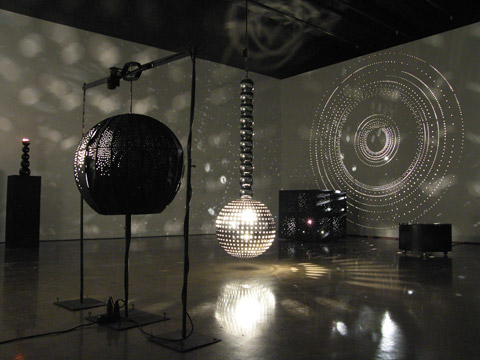
TECHNOLOGY RECLAIMED The pieces of “Lichtballett” suggest a more playful imagining of the night sky by former anti-aircraft gunner Otto Piene. |
"Hans Haacke 1967" at MIT's List Visual Arts Center is a science museum presentation with the educational explanation stripped away, leaving just wonder. Fans cause a silvery 17-foot-wide, 39-foot-long sheet to ripple like big, soft ocean waves. A mini-parachute resembling a jellyfish floats above a blowing fan. A large helium balloon hovers in mid air. A fan blowing up at an angle below and to the side of it seems like it should blow the balloon across the room; but the balloon floats where the air blast, the low pressure zone it creates, and gravity fall into equilibrium. To those not boned up on the Bernoulli effect — or even to those who are — it looks like magic.Haacke, who has been based in New York since the '60s, is best known for strident political installations that interrogate the politics, power, and money behind the art world — and the world at large. Here MIT professor Caroline Jones snappily recreates an exhibit Haacke had at MIT in 1967 to show how his early work poetically and wittily explored natural systems.
The most famous work here — probably because it fits the Minimalist aesthetic — is a plastic cube with water condensing inside. Like the cone of dirt beginning to sprout grass or the column of ice also on display, it's more straightforward and less marvelous than the hovering pieces.
A second gallery documents Haacke's contemporaneous ephemeral projects: a rainbow twinkling in an artificial rain created by sprinklers; 10 pet-store turtles bought and set free; breadcrumbs scattered at sea to attract seagulls; a bunch of bottles, crates, nets, and other flotsam piled into a heap as a Monument to Beach Pollution. They are impish, thoughtful, humane explorations of earthly phenomena.
Also at the List (20 Ames Street, Cambridge, through December 31) is "Lichtballett" by Otto Piene, the retired, longtime director of the Center for Advanced Visual Studies, who now splits his time between Groton and Dusseldorf. Electric Rose (1965) is an aluminum globe studded with lightbulbs standing atop a chromed pipe. The orange bulbs click on one hemisphere at a time with a purple bulb lighting up on top. It's slow and perhaps too simple, but looks like the Death Star or home décor from a Stanley Kubrick sci-fi flick.
In the next room, curator João Ribas has assembled a hanging metal globe, an aluminum drum, stacked round lamps, and a big disco ball from the '60s, plus a steel cube and perforated wall from the past two years. They project dotted patterns of light as well as connect-the-dots jellyfish cartwheeling across the walls. They're astonishing, trippy, mind-expanding constellations.